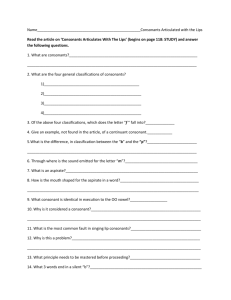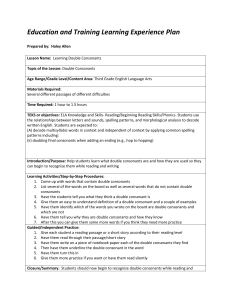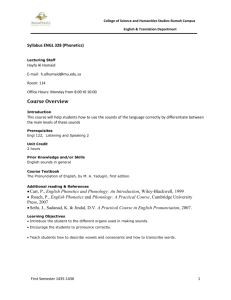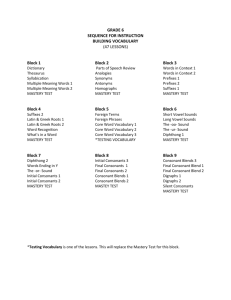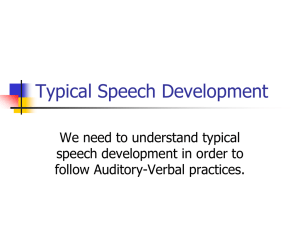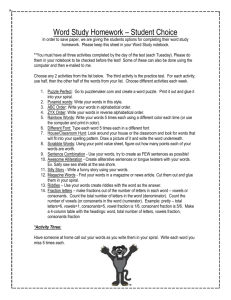docx - Ally.Ru
advertisement
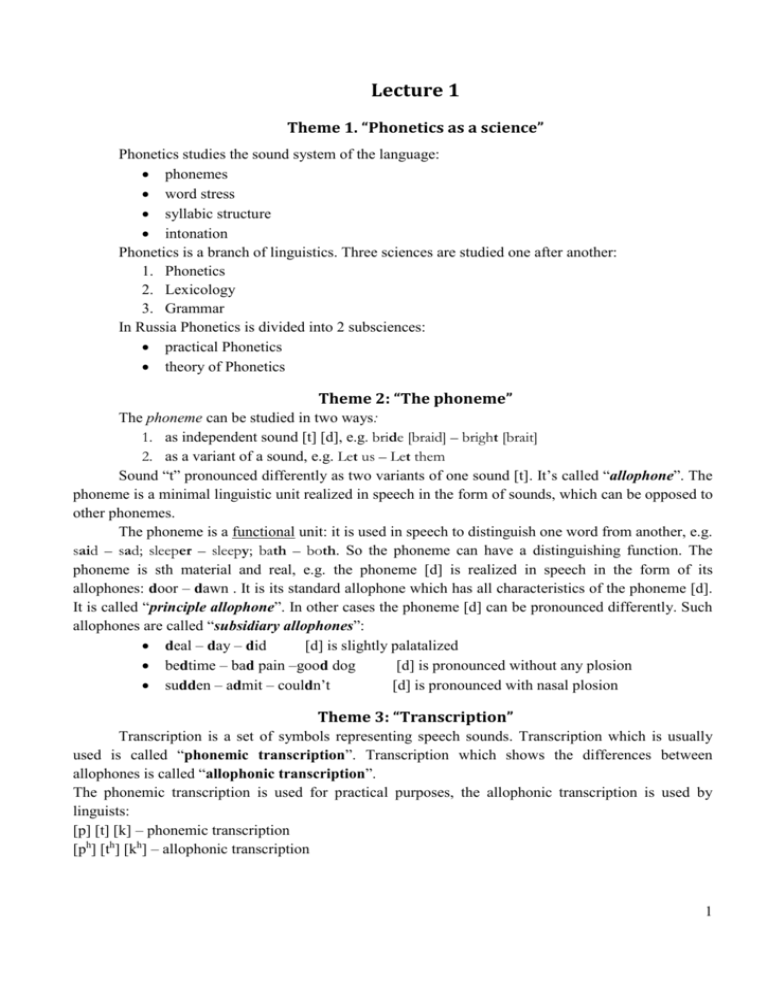
Lecture 1 Theme 1. “Phonetics as a science” Phonetics studies the sound system of the language: phonemes word stress syllabic structure intonation Phonetics is a branch of linguistics. Three sciences are studied one after another: 1. Phonetics 2. Lexicology 3. Grammar In Russia Phonetics is divided into 2 subsciences: practical Phonetics theory of Phonetics Theme 2: “The phoneme” The phoneme can be studied in two ways: 1. as independent sound [t] [d], e.g. bride [braid] – bright [brait] 2. as a variant of a sound, e.g. Let us – Let them Sound “t” pronounced differently as two variants of one sound [t]. It’s called “allophone”. The phoneme is a minimal linguistic unit realized in speech in the form of sounds, which can be opposed to other phonemes. The phoneme is a functional unit: it is used in speech to distinguish one word from another, e.g. said – sad; sleeper – sleepy; bath – both. So the phoneme can have a distinguishing function. The phoneme is sth material and real, e.g. the phoneme [d] is realized in speech in the form of its allophones: door – dawn . It is its standard allophone which has all characteristics of the phoneme [d]. It is called “principle allophone”. In other cases the phoneme [d] can be pronounced differently. Such allophones are called “subsidiary allophones”: deal – day – did [d] is slightly palatalized bedtime – bad pain –good dog [d] is pronounced without any plosion sudden – admit – couldn’t [d] is pronounced with nasal plosion Theme 3: “Transcription” Transcription is a set of symbols representing speech sounds. Transcription which is usually used is called “phonemic transcription”. Transcription which shows the differences between allophones is called “allophonic transcription”. The phonemic transcription is used for practical purposes, the allophonic transcription is used by linguists: [p] [t] [k] – phonemic transcription [ph] [th] [kh] – allophonic transcription 1 Theme 4: “The system of English phonemes” There are two main classes traditionally distinguished by phoneticians of any language. They are called consonants and vowels. Consonants are pronounced with noise and voice combined, vowels are pronounced with voice only. The difference is in different work of organs of speech. In the case of vowels no obstruction is made. In the case of consonants different obstructions are made. So consonants are characterized by the so-called close articulation (the blockage of can be complete, partial and intermittent). The blockage is made by organs of speech so consonants are always characterized by noise. 4.1 Consonants On the articulatory level every consonant can be characterized by 2 facts: 1) in what articulatory position are organs of speech while pronouncing this consonant; 2) where in the mouth this consonant is formed. Also a lot of other factors can influence the pronunciation of this consonant, for example: by what organ of speech the obstruction is made; in what position are “vocal cords” (голосовые связки); with what power this consonant is pronounced and so on … All consonants can be classified in different ways. 1. Classification of Vassilyev There are 2 main factors according to which all consonants can be classified: 1) the type of obstruction 2) the manner of production of noise There are 2 classes of consonants: 1) occlusive (смычные), in the production of which a complete obstruction is made; 2) constrictive (щелевые), in the production of which an incomplete obstruction is made. смычной tea seed pull boat щелевой sea seas full vote Each of these 2 classes is subdivided into noise consonant and sonorant. The factors of dividing these sounds is prevailing of noise or tone (голоса) in characteristics of a sound. In their turn noise consonants are divided into plosive (взрывные) [d] [tʃ] and affricates [ʤ] [ʧ]. 2 Consonants constrictive occlusive sonorants noise plosives sonorants noise medial lateral (срединный) (боковой) affricats 2. Classification of Sokolova and Tikhonov The factor of their classification is the degree of noise. There are 2 classes of consonants: noise sonorants Sonorants are the most debated consonants. The point is (факт в том) that they are pronounced differently from all other consonants. There air passage (поток воздуха) between organs of speech is very wide, much wider than in the production of other consonants. As a result we hear not noise but tone so sonorants sound more like vowels than consonants. Some British phoneticians refer them to the class of semivowels [w] [j] [r]. Soviet and Russian phoneticians think that these are consonants. Consonants sonorants noise occlusive occlusiveconstrictive (смычно-щелевой) costrictive occlusive constrictuve medial lateral Resume: there are 2 factors that are most important in classification of sounds 3 degree of noise manner of articulation The place of articulation is another very important characteristic of English consonants. According to it all English consonant can be classified into: labial (губные) lingual (смычные) glottal (гортанные) Labial can be subdivided into: bilabial labio-dental Lingual are subdivided into: forelingual (передне-язычный) mediolingual backlingual Consonants labial bilabial glottal lingual labio-dental forelingual mediolingual backlingual Examples: pan – tan (bilabial – forelingual) why – lie (bilabial – forelingual) weil – yale (bilabial – mediolingual) pick – kick (bilabial – backlingual) less – yes (forelingual – mediolingual) day – gay (forelingual – backlingual) sigh – high (forelingual – glottal) feet – seat (labio-dental – forelingual) 4

